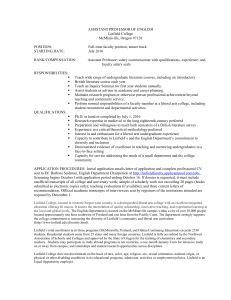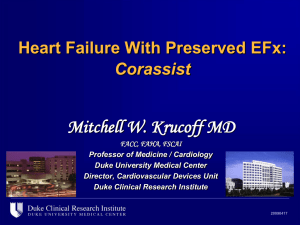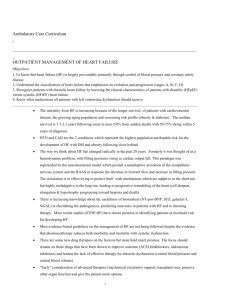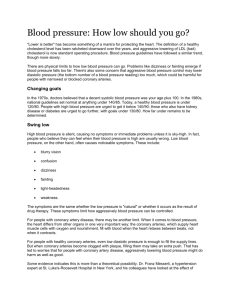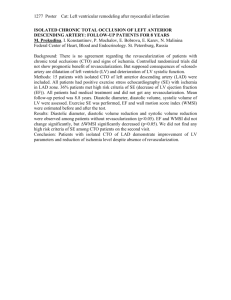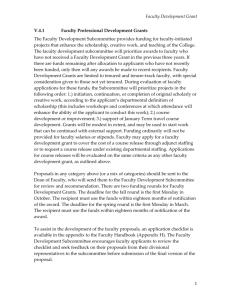review of the diagnosis and treatment of diastolic heart failure
advertisement
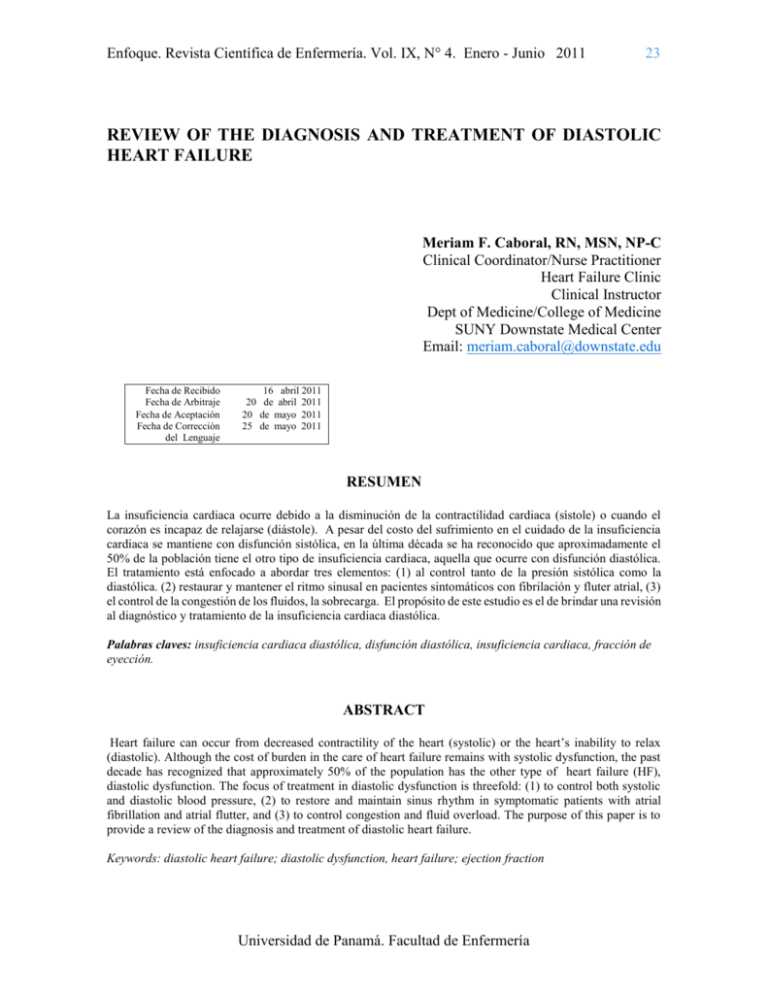
Enfoque. Revista Científica de Enfermería. Vol. IX, N° 4. Enero - Junio 2011 23 REVIEW OF THE DIAGNOSIS AND TREATMENT OF DIASTOLIC HEART FAILURE Meriam F. Caboral, RN, MSN, NP-C Clinical Coordinator/Nurse Practitioner Heart Failure Clinic Clinical Instructor Dept of Medicine/College of Medicine SUNY Downstate Medical Center Email: meriam.caboral@downstate.edu Fecha de Recibido Fecha de Arbitraje Fecha de Aceptación Fecha de Corrección del Lenguaje 16 abril 2011 20 de abril 2011 20 de mayo 2011 25 de mayo 2011 RESUMEN La insuficiencia cardiaca ocurre debido a la disminución de la contractilidad cardiaca (sístole) o cuando el corazón es incapaz de relajarse (diástole). A pesar del costo del sufrimiento en el cuidado de la insuficiencia cardiaca se mantiene con disfunción sistólica, en la última década se ha reconocido que aproximadamente el 50% de la población tiene el otro tipo de insuficiencia cardiaca, aquella que ocurre con disfunción diastólica. El tratamiento está enfocado a abordar tres elementos: (1) al control tanto de la presión sistólica como la diastólica. (2) restaurar y mantener el ritmo sinusal en pacientes sintomáticos con fibrilación y fluter atrial, (3) el control de la congestión de los fluidos, la sobrecarga. El propósito de este estudio es el de brindar una revisión al diagnóstico y tratamiento de la insuficiencia cardiaca diastólica. Palabras claves: insuficiencia cardiaca diastólica, disfunción diastólica, insuficiencia cardiaca, fracción de eyección. ABSTRACT Heart failure can occur from decreased contractility of the heart (systolic) or the heart’s inability to relax (diastolic). Although the cost of burden in the care of heart failure remains with systolic dysfunction, the past decade has recognized that approximately 50% of the population has the other type of heart failure (HF), diastolic dysfunction. The focus of treatment in diastolic dysfunction is threefold: (1) to control both systolic and diastolic blood pressure, (2) to restore and maintain sinus rhythm in symptomatic patients with atrial fibrillation and atrial flutter, and (3) to control congestion and fluid overload. The purpose of this paper is to provide a review of the diagnosis and treatment of diastolic heart failure. Keywords: diastolic heart failure; diastolic dysfunction, heart failure; ejection fraction Universidad de Panamá. Facultad de Enfermería Enfoque. Revista Científica de Enfermería. Vol. IX, N° 4. Enero - Junio 2011 INTRODUCTION Heart failure (HF) is a progressive disease that affects approximately 5 million Americans, and this number continuous to grow with the aging population (American Heart Association, 2010, Brookes, L & Solomon, Sd., 2006). Despite advances in medical therapy, HF is associated with high morbidity, mortality, and rehospitalization (≤ 30 days) rates (American Heart Association, 2010). The cost of burden of direct and indirect care of someone with HF is an estimated $39B per year (American Heart Association, 2010,). Although the current focus of stringent care is with systolic HF, the past decade has recognized that approximately 40-50% of the population has diastolic dysfunction, and that the morbidity rate including rehospitalization is similar to those with systolic HF (Brookes, L & Solomon, Sd.,2006, Hamlin, SK. y Cols., 2004, Kuznetsova, L, y Cols., 2010). This article will review the diagnosis and treatment of diastolic HF. Types OF HF There are currently two different types of HF – systolic, which can occur from decreased contractility of the heart, and diastolic, in which the heart is unable to relax (Gutierrez, C, &Blachard, Dg., 2004). Initially, identifying the left ventricular ejection fraction (LVEF) distinguishes between systolic HF (SHF) and diastolic HF (DHF). In systolic HF, the left ventricular ejection fraction (LVEF) is ≤ 40% whereas in diastolic HF (DHF), the LVEF is ≥ 45%. The terms DHF, HF with normal LVEF, HF with preserved LVEF (PLVEF), and diastolic dysfunction (DD) have been used 24 interchangeably. By definition, DD refers to the abnormalities noted in ventricular filling and relaxation, whereas DHF is a clinical syndrome as evident by volume overload and decompensation often requiring hospitalization (Hamlin, SK. y Cols., 2004). Diastole is a process of passive elastic property and active relaxation (Aurigemma, y Cols. 2004). In DHF, there is impaired relaxation, which increases stiffness of the LV causing reduced chamber compliance and reduced filling time (Gutierrez, C, &Blachard, Dg., 2004 Kuznetsova, L, y Cols., 2010), Aurigemma, G. P. y Gaasch, W. H, 2004, Linfield, J, y Cols., 2010). Similar to SHF, the neurohormonal cascades including the renin-angiotensin (RAS) and the sympathetic nervous (SNS) systems are activated in DHF (Linfield, J, y Cols., 2010). Stages of HF In 2005, a new staging system was developed to show the development and progression of the disease (Hun, 2005). The first two stages (Stages A and B) describes those patients that do not have HF but are at high risk of developing the disease. Stages C and D are those patients who have a definitive diagnosis of HF. Stage A are those who have risk factors associated with the development of HF, such as hypertension; whereas Stage B are those with structural heart disease but are asymptomatic (Hun, 2005). Stage C patients are those who currently or previously had symptoms of HF, and those patients in Stage D are those characterized by refractory HF who may require specialized intervention (Hun, 2005). Universidad de Panamá. Facultad de Enfermería Enfoque. Revista Científica de Enfermería. Vol. IX, N° 4. Enero - Junio 2011 Causes of DHF Hypertensive LVH is the most common cause of DHF, however coronary artery disease and diabetes are known to be associated with the development of DD (Gutierrez, C, &Blachard, Dg., 2004, Aurigemma, G. P. y Gaasch, W. H, 2004, Linfield, J, y Cols., 2010),Satpathy, C, y Cols., 2006). Valvular disorders, mainly aortic stenosis, obesity and aging are also common causes (Satpathy, C, y Cols., 2006). Cardiomyopathy (genetic, postpartum, viral, and drug and/or radiation) and infiltrative myopathy are two other disease processes that may lead to DD (Linfield, J, y Cols., 2010)). Common precipitating factors of include volume overload, tachycardia, arrhythmia including atrial fibrillation, increased salt intake and use of non-steroidal drugs (Satpathy, C, y Cols., 2006). Other uncommon causes of DHF include pericardial disorder, and conditions such as anemia and presence of AV fistula (Linfield, J, y Cols., 2010, Satpathy, C, y Cols., 2006). Diagnosis DHF Obtaining a thorough clinical history and physical exam remains crucial in making the diagnosis of DHF. Patients with DHF may have the same signs and symptoms similar to someone with SHF. However, in patients with DHF, the symptom of decreased exercise tolerance because of increased LV diastolic and pulmonary venous pressures (Aurigemma, G. P. y Gaasch, W. H, 2004). This is as a result of decreased lung compliance and inadequate cardiac output during exercise thus leading to leg fatigue and use of respiratory accessory muscles 25 (Aurigemma, G. P. y Gaasch, W. H, 2004). A European study group proposed a classification schema for diagnosing DHF based on the degree of diagnostic certainty from “definite” via “probable” to “possible” (Kraajj, D. J., Cols. 2002). A definitive diagnosis of DHF has evidence of congestive HF (CHF), objective evidence of normal LV systolic function (LVSF) of 50% or more within 72 hours of event, and LV diastolic dysfunction, based upon abnormal LV relaxation or filling or distensibility indices on cardiac catheterization (Kraajj, D. J., Cols. 2002). A probable diagnosis of DH has the same evidence of CHF and evidence of normal LVSF, however has no conclusive information on LV diastolic function (Kraajj, D. J., Cols. 2002). In possible DHF, have evidence of CHF, and LVEF of ≥ 50% but not within the 72 hours of event (Kraajj, D. J., Cols. 2002). Other criteria for assessing and diagnosing SHF and DHF are available from the American College of Cardiology, Duke, and Boston. As mentioned earlier, since patients with DHF can also present with signs and symptoms similar to systolic HF, diagnosis can established by quantifying LVEF, volume, dimensions, and thickness using imaging techniques such as echocardiogram, cardiac magnetic imaging or cardiac catheterization (Hamlin, SK. y Cols., 2004,Galderisi, M. (2005). Echocardiography should be considered first over these other techniques simply because it is the cheapest and the least invasive to the person. Other information that can be obtained from these tests includes valvular function, filling patterns, cardiac anatomy, and left atrial enlargement in the absence of atrial fibrillation (Linfield, J, y Cols., Universidad de Panamá. Facultad de Enfermería Enfoque. Revista Científica de Enfermería. Vol. IX, N° 4. Enero - Junio 2011 2010). It is recommended that careful attention to differential diagnosis including ischemia through echocardiogram, electrocardiogram, stress imaging, and cardiac catheterization because treatment to various cardiac disorders may be different (Linfield, J, y Cols., 2010). The use of B-type natriuretic peptide (BNP) or NT-proBNP may assist health care providers to determine whether dyspnea is due to heart failure or noncardiac causes (Linfield, J, y Cols., 2010). These peptides are released from the LV in response to increased volume and pressure (Linfield, J, y Cols., 2010). It is important however to note that elevated levels of BNP or NT- proBNP do not differentiate between systolic and diastolic dysfunction (Gutierrez, C, & Blachard, Dg., 2004 , Hamlin, SK. y Cols., 2004, Linfield, J, y Cols., 2010). Likewise, levels of BNP and NT- proBNP also vary by age, gender, weight, and renal function (Linfield, J, y Cols., 2010). A diagnostic algorithm was developed in the 2010HFSA guidelines for patients with PLVEF (Figure 1). This algorithm is categorized whether the patient has a dilated LV or not (Linfield, J, y Cols., 2010). A dilated LV can result in either valvular or non-valvular disease (Aurigemma, G. P. y Gaasch, W. H, 2004). In non-dilated LV, the presence of right ventricular dysfunction and LV thickness, normal or increased, can lead to DD (Linfield, J, y Cols., 2010). Treatment The goals of treatment in DHF include: (1) control congestion or fluid overload, (2) control blood pressure both 26 systolic and diastolic in accordance with published guidelines, and (3) restore and maintain sinus rhythm in patients with symptomatic atrial fibrillation or atrial flutter but measures should be individualized (Linfield, J, y Cols., 2010,Kantharia, BK. , 2010). Thiazide and loop diuretics are recommended if clinical evidence of fluid overload or overt congestion is present (Linfield, J, y Cols., 2010). Treatment with loop diuretic should be implemented if the use of thiazide diuretic is not adequate (Linfield, J, y Cols., 2010). Excessive diuresis, however should be avoided to prevent orthostatic changes, worsening renal function, and electrolytes abnormalities (Linfield, J, y Cols., 2010). Additionally, sodium and fluid restrictions to ≤ 2L/day should be done when hyponatremia is present (sodium level is <130 mg/dl). Likewise, ultrafiltration may also be considered if diuresis is not effective (Linfield, J, y Cols., 2010). Since hypertension is the most common cause of DHF, drug therapies include the use of angiotensin converting enzyme inhibitor (ACE-1) or angiotensin receptor blockers (ARB), beta blockers, and calcium channel blockers (Linfield, J, y Cols., 2010). The use of ACE-1 should be considered in all patients with Diabetes Mellitus DD who have established cardiovascular disease or DM plus one additional risk factor. Additionally, ARB should be considered to those who are intolerant of ACE-1 (Linfield, J, y Cols., 2010). Beta-blockers is recommended to those patients who have prior myocardial infarction, those with hypertension, and atrial fibrillation requiring ventricular rate control (Linfield, J. y Cols., 2010). Calcium channel blockers (CCB) should be considered in patients with DD and Universidad de Panamá. Facultad de Enfermería Enfoque. Revista Científica de Enfermería. Vol. IX, N° 4. Enero - Junio 2011 symptom-limiting angina, and hypertension (Linfield, J, y Cols., 2010). Likewise, diltiazem or verapamil are the CCBs that should be considered in patients with DD and atrial fibrillation who require ventricular rate control and those who are unable to tolerate beta blockers (Linfield, J. y Cols., 2010). Atrial fibrillation and atrial flutter are not uncommon in the setting of DHF (Hun, 2005). Patients with HF are generally at an increased risk to developing atrial fibrillation and atrial flutter because of increased end-diastolic pressures and atrial distention (Gutierrez, C, & Blachard, Dg., 2004, Kuznetsova, L, y Cols., 2010). The new HFSA guidelines considered that it may be reasonable to attempt to restore to sinus rhythm in patients who remained symptomatic after adequate rate control (Linfield, J.y Cols., 2010). Digoxin is the drug frequently use for rate control. The use of amiodarone and dofetilide has shown to increase conversion to sinus rhythm in some subsets of patients with HF (Linfield, J. y 27 Cols., 2010). Likewise, ablative therapy may be considered in patients with atrial fibrillation to improve symptoms (Linfield, J. y Cols., 2010). CONCLUSION HF is a growing epidemic and DHF is slowly becoming recognized as a major health care issue. As health care providers, we are at the frontline of taking care of these patients who may potentially unbeknown to us to have DD and DHF, particularly those with hypertension. Understanding the problem is just the beginning. Knowing how to diagnose and initiate treatment early is important to delay the progression of the condition to systolic dysfunction, which is irreversible. Becoming familiar with the guidelines can help or can assist health care providers including nurse practitioners to deliver evidenced-based quality of care. In the end, it is our responsibility as healthcare professionals to create plans of care to increase adherence of these patients to their medical regimen. Universidad de Panamá. Facultad de Enfermería Enfoque. Revista Científica de Enfermería. Vol. IX, N° 4. Enero - Junio 2011 REFERENCES BIBLIOGRAPHIC AMERICAN HEART ASSOCIATION. (2010). Heart and Stroke Statistics. Retrieved from: www.americanheart.org. 29 HAMLIN, SK, VILLARS, PS, KANUSKY, JT, AND SHAW, AD. Role of diastole in left ventricular function II: Diagnosis and treatment. Amer J Crit Care,2004;13(6):453468. BROOKES, L & SOLOMON, SD. (2006).Diastolic heart failure and RAAS inhibition.Medscape Cardiology;10(2).Retrieved from: http:cme.medscape.com/viewarticle/5 48192. KUZNETSOVA, L, HERBOTS, L, JIN Y, STOLARZ-SKRZYPEK, K AND STAENSSEN, JA. (2010). Systolic and diastolic left ventricular dysfunction: From risk factors to overt heart failure. Expert Rev Cardiovasc Ther;8(2):251-258. GUTIERREZ, C, & BLACHARD, DG. Diastolic heart failure: Challenges of diagnosis and treatment. AmerFam Physician, 2004;69 (11):2609-2617. AURIGEMMA, G. P. AND GAASCH, W. H. Diatolic heart failure.New Engl J of Medicine; (2004); 351:1097-1105. Universidad de Panamá. Facultad de Enfermería Enfoque. Revista Científica de Enfermería. Vol. IX, N° 4. Enero - Junio 2011 24 LINFIELD, J, ALBERT, NM, BOEHMER, JP, COLLINS, SP, EZEKOWITZ, JA, GIVERTZ, NM ET AL., Executive Summary: HFSA 2010 Comprehensive Heart Failure Practice Guidelines. J Card Fail, 2010;16:475-539. SATPATHY, C, MISHRA, T. K, SATPATHY, T., SATPATHY, H. K. AND BARONE, E. (2006).Diagnosis and management of diastolic dysfunction and heart failure.Amer Family Physician;73(5):847-846. GALDERISI, M. (2005). Diastolic dysfunction and diastolic heart failure: Diagnostic, prpognostic and therapeutic aspects. Cardiovascular Ultrasound;3(9). Retrieved from: http:www.cardiovascularultrasound.c om/content/3/1/9.doi:10.1186/14767120-3-9. KRAAJJ, D. J., VAN POL, P. E., RUITERS, A. W., DE SWART, J. B., LIPS, D., J., HUNT SA, ABRAHAM WT, CHIN MH, FELDMAN AM, FRANCIS GS, GANIATS TG, ET AL. American College of Cardiology/ American Heart Association 2005 Heart Failure Guideline Update for the diagnosis and management of chronic heart failure in the adult – Summary article. Circ. 2005; 112:1825-1852. LENCER, N., ET AL., (2002). Diagnosing diastolic heart failure.European J of Heart Fail;4:419-430. KANTHARIA, BK. (2010). Cardiac arrhythmias in congestive heart failure.ExpertRevCardiovasc Ther;8(2):137-140. Universidad de Panamá. Facultad de Enfermería
